oil pressure CHEVROLET BLAZER 1997 2.G Owners Manual
[x] Cancel search | Manufacturer: CHEVROLET, Model Year: 1997, Model line: BLAZER, Model: CHEVROLET BLAZER 1997 2.GPages: 402, PDF Size: 21.93 MB
Page 6 of 402
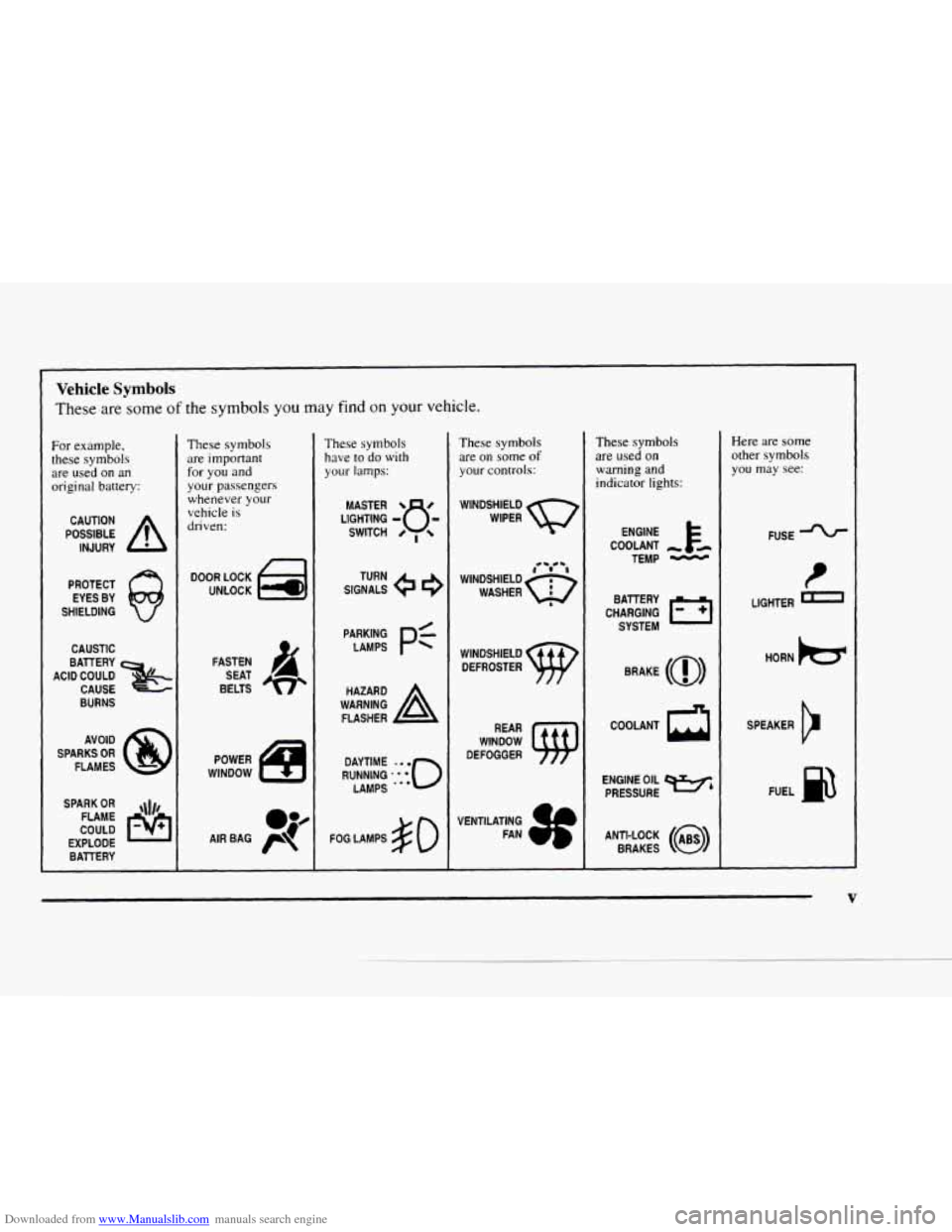
Downloaded from www.Manualslib.com manuals search engine Vehicle Symbols
These are some of the symbols you may find on your vehicle.
For example,
these symbols
are used on an
original battery:
POSSIBLE A
CAUTION
INJURY
PROTECT EYES BY
SHIELDING
CAUSTIC
ACID COULD
x
BATTERY CAUSE
BURNS
AVOID
SPARKS
OR
FLAMES
SPARK
OR ,\I/,
COULD FLAME
EXPLODE BATTERY
These symbols
are important
for you
and
your passengers
whenever your
vehicle
is
driven:
DOOR LOCK
UNLOCK
These symbols have
to do with
your lamps:
FASTEN
SEAT
BELTS
POWER
WINDOW
't -I
SIGNALS TURN
A
FLASHER
FOG LAMPS
$0
These symbols
are
on some of
your controls:
WINDSHIELD
WIPER
WINDSHIELD DEFROSTER
WINDOW
DEFOGGER
VENTILATING FAN
1 b
-J
These symbols
are used on
warning and
indicator lights:
COOLANT
TEMP
-
CHARGING EATERY
SYSTEM
BRAKE
(a)
ENGINE OIL e,
PRESSURE
ANTI-LOCK
(@)
BRAKES
Here are some
other symbols
you may see:
FUSE *
I
LIGHTER
HORN
)a(
SPEAKER
b
FUEL la
V
Page 136 of 402
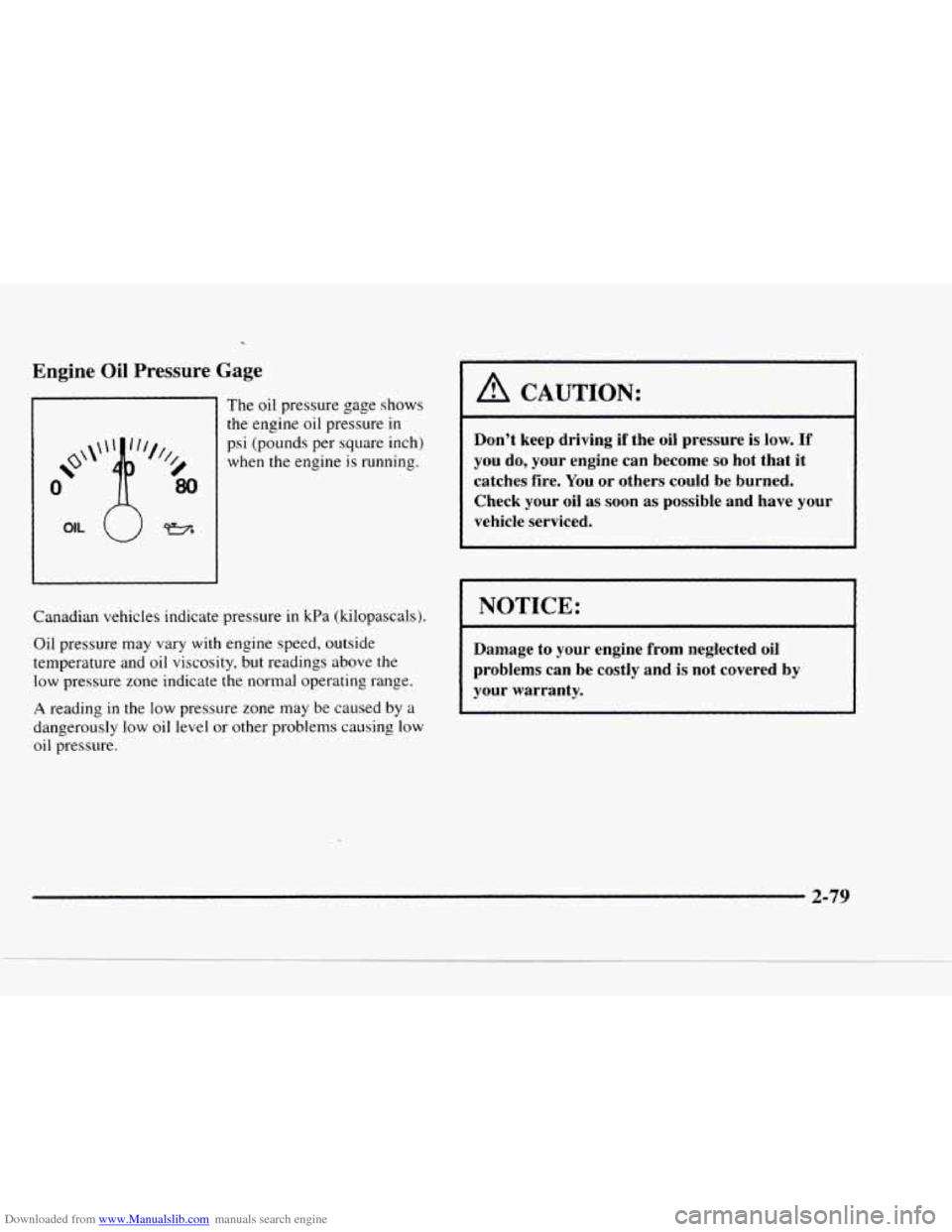
Downloaded from www.Manualslib.com manuals search engine Engine Oil Pressure Gage
011 0-
The oil pressure gage shows
the engine oil pressure in
psi (pounds per square inch)
when the engine
is running.
Canadian vehicles indicate pressure in kPa (kilopascals).
Oil pressure may vary with engine speed, outside
temperature and oil viscosity, but readings above the
low pressure zone indicate
the normal operating range.
A reading in the low pressure zone may be caused by a
dangerously low oil level or other ~roblems causing low
oil pressure.
A CAUTION:
Don't keep driving if the oil pressure is low. If
you do, your engine can become
so hot that it
catches fire.
You or others could be burned.
Check your oil
as soon as possible and have your
vehicle serviced.
NOTICE:
Damage to your engine from neglected oil
problems can be costly and is not covered by
your warranty.
2-79
Page 137 of 402

Downloaded from www.Manualslib.com manuals search engine Shift Light
-w
/fls 1
You have the shift light
if you have a manual
transmission. This light
comes
on very briefly as a
bulb check when
you start
the engine. Shifting when
the indicator light is on will
help you get
the best fuel
economy. See "Shift Light"
in the Index.
1 'd 8.
Daytime Running Lamps Indicator Light
This light is on the
instrument panel. It goes on
whenever the
DRL are on,
the ignition is on,.the
headlamp switch is
off
and the parking brake is
released.
Check Gages Light
CHECK GAGES
The CHECK GAGES light
will come on briefly when
you are starting the engine.
:
.. * ,. ,. , i ..3
I I.. -_. .
If the light comes on and stays on while you are driving,
check your coolant temperature and engine oil pressure
gages to see if they are in the warning zones.
1;
.I. ..
' , .;i ,- ..
"j
.. . .
2-80
Page 195 of 402
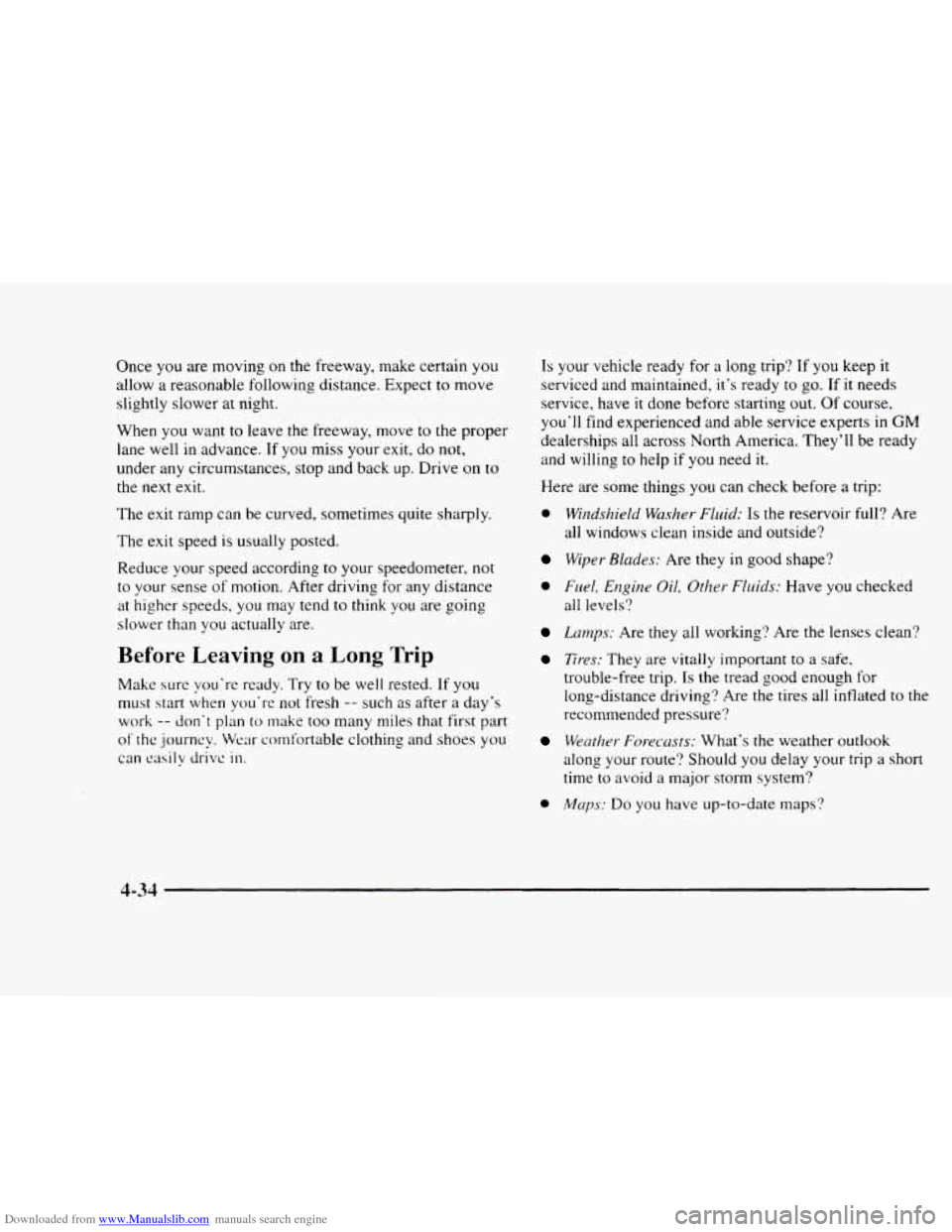
Downloaded from www.Manualslib.com manuals search engine Once you are moving on the freeway, make certain you
allow a reasonable following distance. Expect to move
slightly slower at night.
When you want
to leave the freeway, move to the proper
lane well
in advance. If you miss your exit, do not,
under any circumstances, stop and back up. Drive on to
the next exit.
The exit ramp can be curved, sometimes quite sharply.
The exit speed is usually posted.
Reduce your speed according to your speedometer,
not
to your sense of motion. After driving for any distance
at higher speeds, you may tend to think you are going
slower than
you actually are.
Before Leaving on a Long Trip
Make sure you're ready. Try to be well rested. If you
must start when you're not fresh -- such as after a day's
work -- don't plan to make too many miles that first part
of the journcv. Wear comfortable clothing and shoes you
can easily drive in.
Is your vehicle ready for a long trip? If you keep it
serviced and maintained,
it's ready to go. If it needs
service, have
it done before starting out. Of course,
you'll find experienced and able service experts
in GM
dealerships all across North America. They'll be ready
and willing to help if
you need it.
Here are some things you can check before a trip:
0 Windshield Washer Fluid: Is the reservoir full? Are
all windows clean inside and outside?
Wiper Blades: Are they in good shape?
0 Fuel, Engine Oil, Other Fluids: Have you checked
all levels?
Lurrzps: Are they all working? Are the lenses clean?
Tires: They are vitally important to a safe,
trouble-free trip.
Is the tread good enough for
long-distance driving? Are
the tires all inflated to the
recommended pressure'?
Weather For-ecvrsts: What's the weather outlook
along your route? Should
you delay your trip a short
time to avoid
a major storm system?
0 Maps: Do you have up-to-date maps'!
4-34
Page 231 of 402
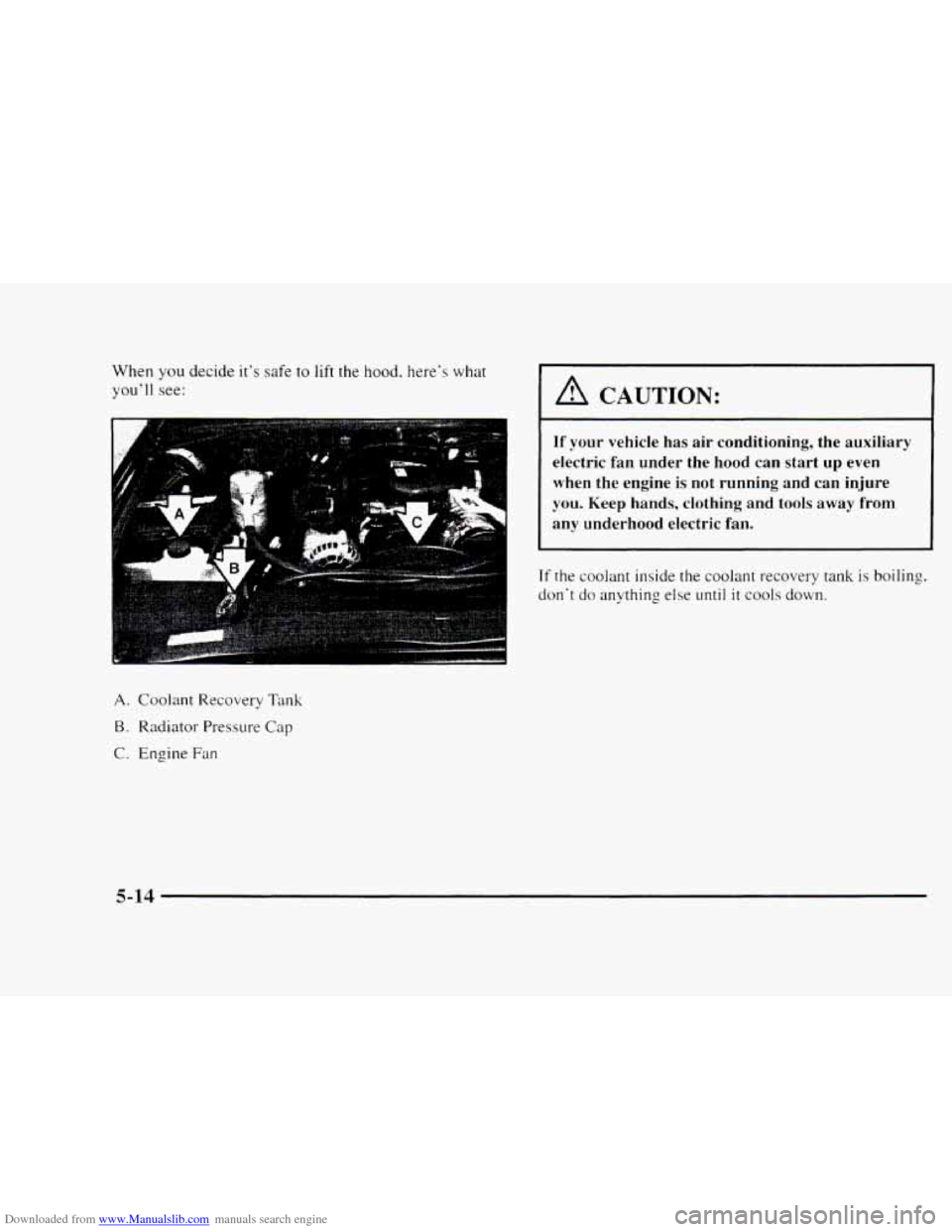
Downloaded from www.Manualslib.com manuals search engine When you decide it's safe to lift the hood. here's what
you'll see:
hi
A. Coolant Recovery Tank
B. Radiator Pressure Cap
C. Engine Fan
A CAUTION:
If your vehicle has air conditioning, the auxiliary
electric fan under the hood can start up even
when the engine is not running and can injure
you. Keep hands, clothing and tools away from
any underhood electric fan.
If the coolant inside the coolant recovery tank is boiling,
don't do anything else until it cools down.
5-14
Page 256 of 402
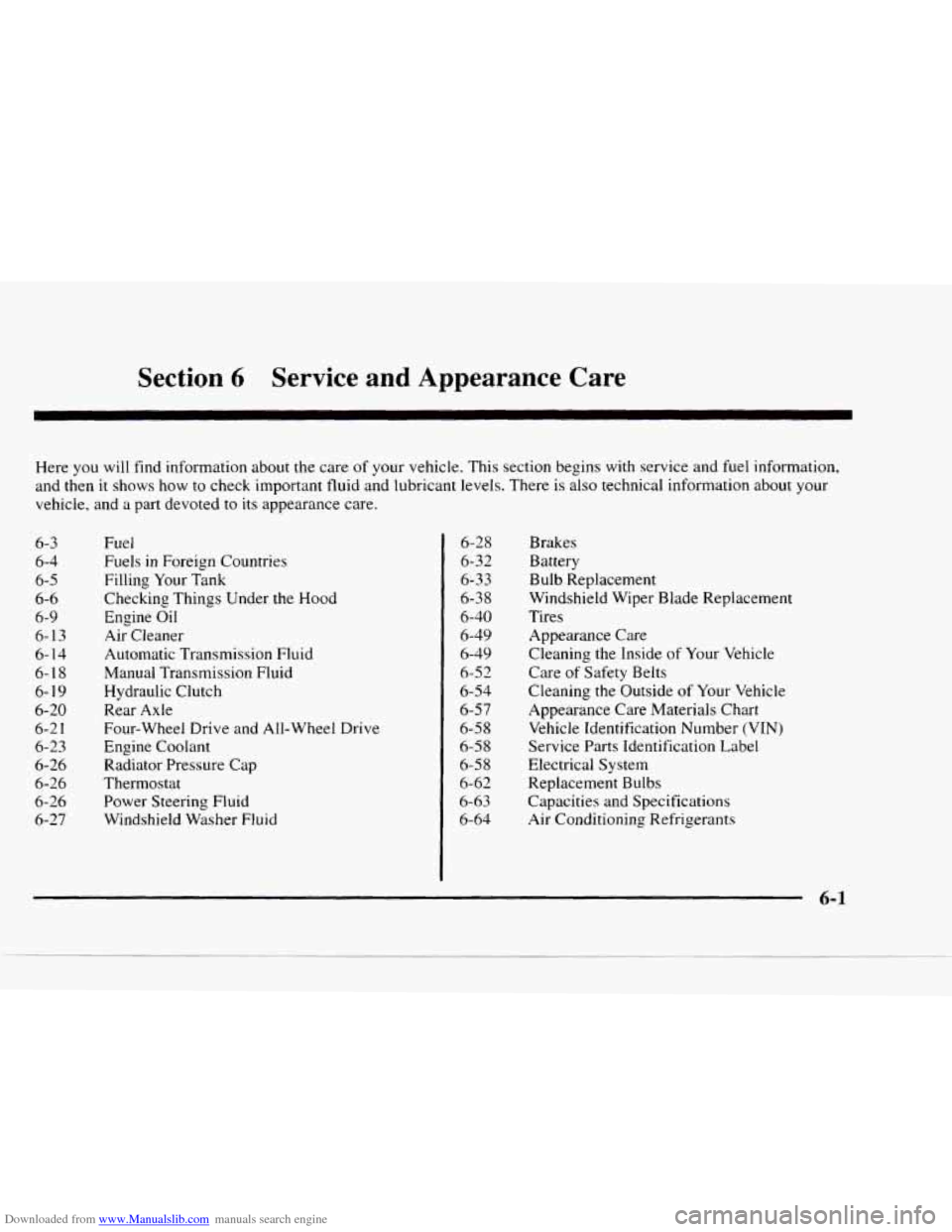
Downloaded from www.Manualslib.com manuals search engine Section 6 Service and Appearance Care
Here you will find information about the care of your vehicle. This section begins with service and fuel information,
and then
it shows how to check important fluid and lubricant levels. There is also technical information about your
vehicle, and a part devoted
to its appearance care.
6-3
6-4
6-5
6-6
6-9 6-
13
6- 14
6-18
6- 19
6-
20
6-2 1
6-23
6-26
6-26
6-26 6-27
Fuel
Fuels in Foreign Countries
Filling Your Tank
Checking Things Under the Hood
Engine Oil
Air Cleaner
Automatic Transmission Fluid
Manual Transmission Fluid
Hydraulic Clutch
Rear Axle
Four-wheel Drive and All-Wheel Drive
Engine Coolant Radiator Pressure Cap
Thermostat Power Steering Fluid
Windshield Washer Fluid 6-28
6-32
6-3 3 6-3 8
6-40 6-49
6-49
6-52
6-54
6-5
7
6-5 8
6-58
6-58
6-62
6-63
6-64
Brakes
Battery
Bulb Replacement
Windshield Wiper Blade Replacement
Tires
Appearance Care
Cleaning the Inside
of Your Vehicle
Care
of Safety Belts
Cleaning the Outside of Your Vehicle
Appearance Care Materials Chart
Vehicle Identification Number
(VIN)
Service Parts Identification Label
Electrical System
Replacement Bulbs
Capacities and Specifications
Air Conditioning Refrigerants
Page 264 of 402
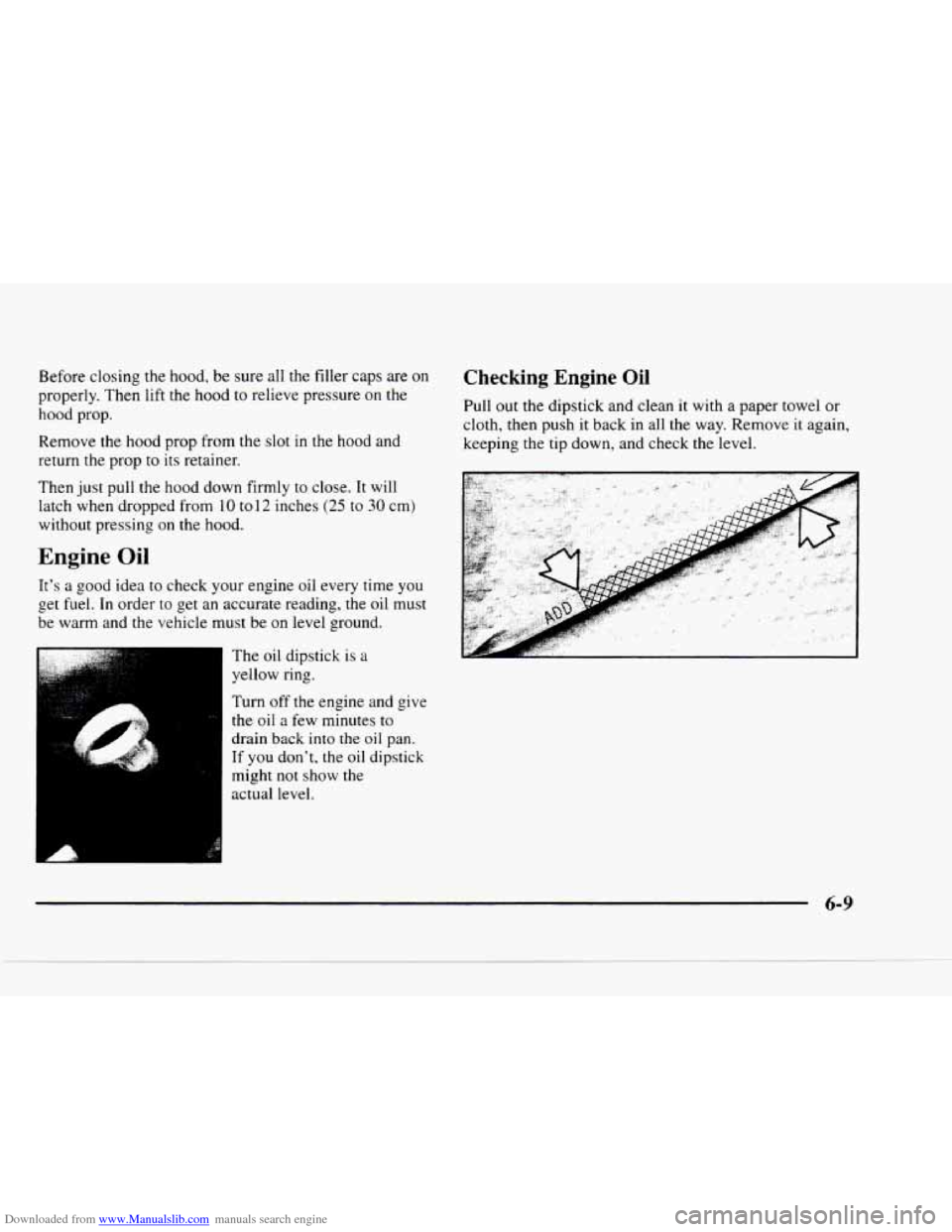
Downloaded from www.Manualslib.com manuals search engine Before closing the hood, be sure all the filler caps are on
properly. Then lift the hood to relieve pressure on the
hood prop.
Remove
the hood prop from the slot in the hood and
return the prop
to its retainer.
Checking Engine Oil
Pull out the dipstick and clean it with a paper towel or
cloth,
then push it back in all the way. Remove it again,
keeping the tip down, and check the level.
Then just pull the hood down firmly
to close. It will
latch when dropped from
10 to12 inches (25 to 30 cm)
without pressing on the hood.
Engine Oil
It’s a good idea to check your engine oil every time you
get fuel. In order to get an accurate reading, the oil must
be warm and the vehicle must be on level ground.
The oil dipstick
is a
yellow ring.
Turn off the engine and give
the oil a few minutes to
drain back into
the oil pan.
If
you don’t, the oil dipstick
might
not show the
actual level.
6-9
Page 305 of 402
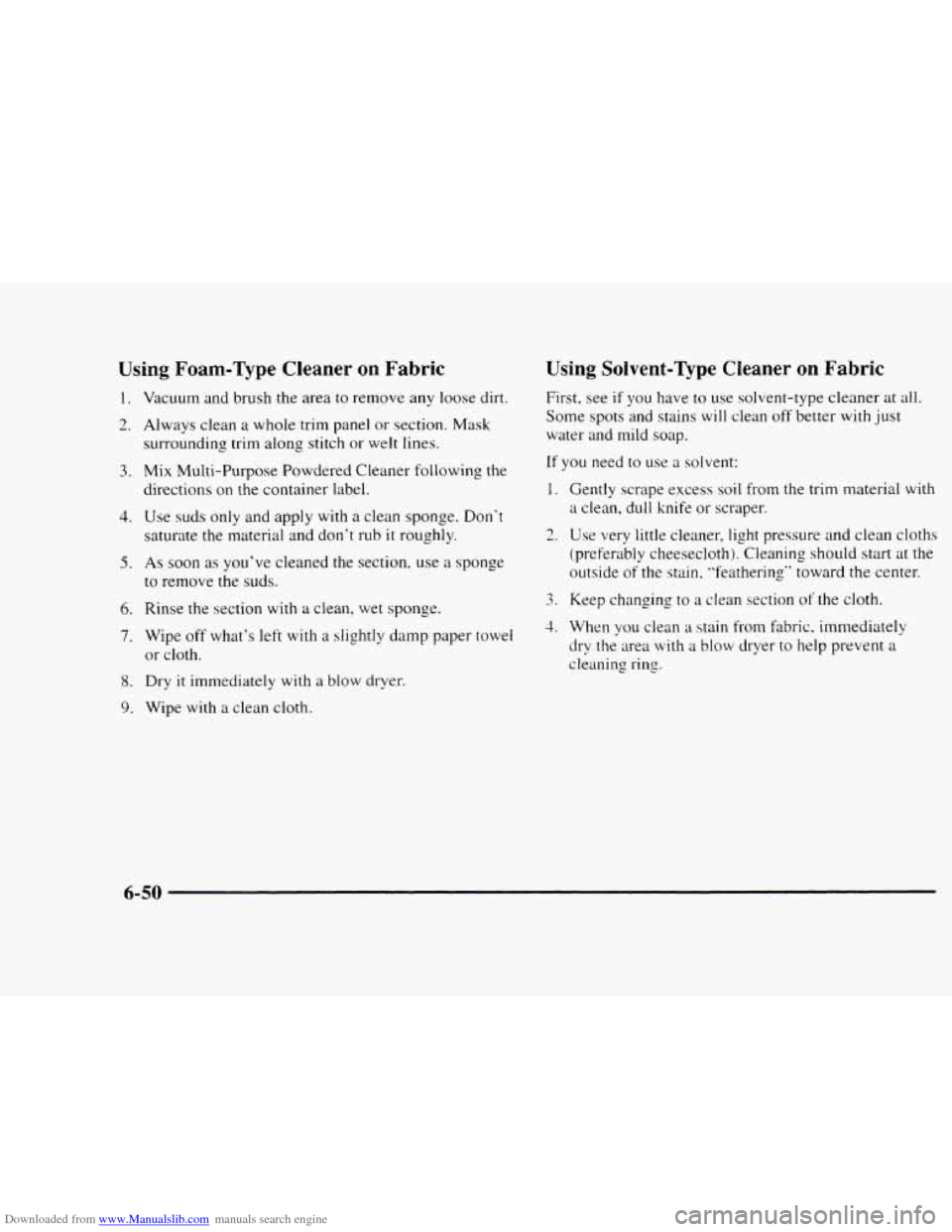
Downloaded from www.Manualslib.com manuals search engine Using Foam-Type Cleaner on Fabric
1.
2.
3.
4.
5.
6.
7.
8.
9.
Vacuum and brush the area to remove any loose dirt.
Always clean a whole trim panel
or section. Mask
surrounding trim along stitch or welt lines.
Mix Multi-Purpose Powdered Cleaner following the
directions
on the container label.
Use suds only and apply with a clean sponge. Don‘t
saturate the material and don’t rub
it roughly.
As soon as you’ve cleaned the section, use a sponge
to remove the suds.
Rinse the section with a clean, wet sponge.
Wipe off what’s left
with a slightly damp paper towel
or cloth.
Dry
it imnlediately with a blow dryer.
Wipe with
a clean cloth.
Using Solvent-Qpe Cleaner on Fabric
First. see if you have to use solvent-type cleaner at all.
Some spots and stains
will clean off better with just
water and mild soap.
If you need to use a solvent:
1. Gently scrape excess soil from the trim material with
a clean. dull knife or scraper.
2. Use very little cleaner, light pressure and clean cloths
(preferably cheesecloth). Cleaning should start at the
outside
of the stain, “feathering” toward the center.
3. Keep changing to a clean section of the cloth.
4. When you clean it stain from fabric. immediately
dry the area
with a blow dryer to help prevent a
cleaning
ring.
6-50
Page 309 of 402
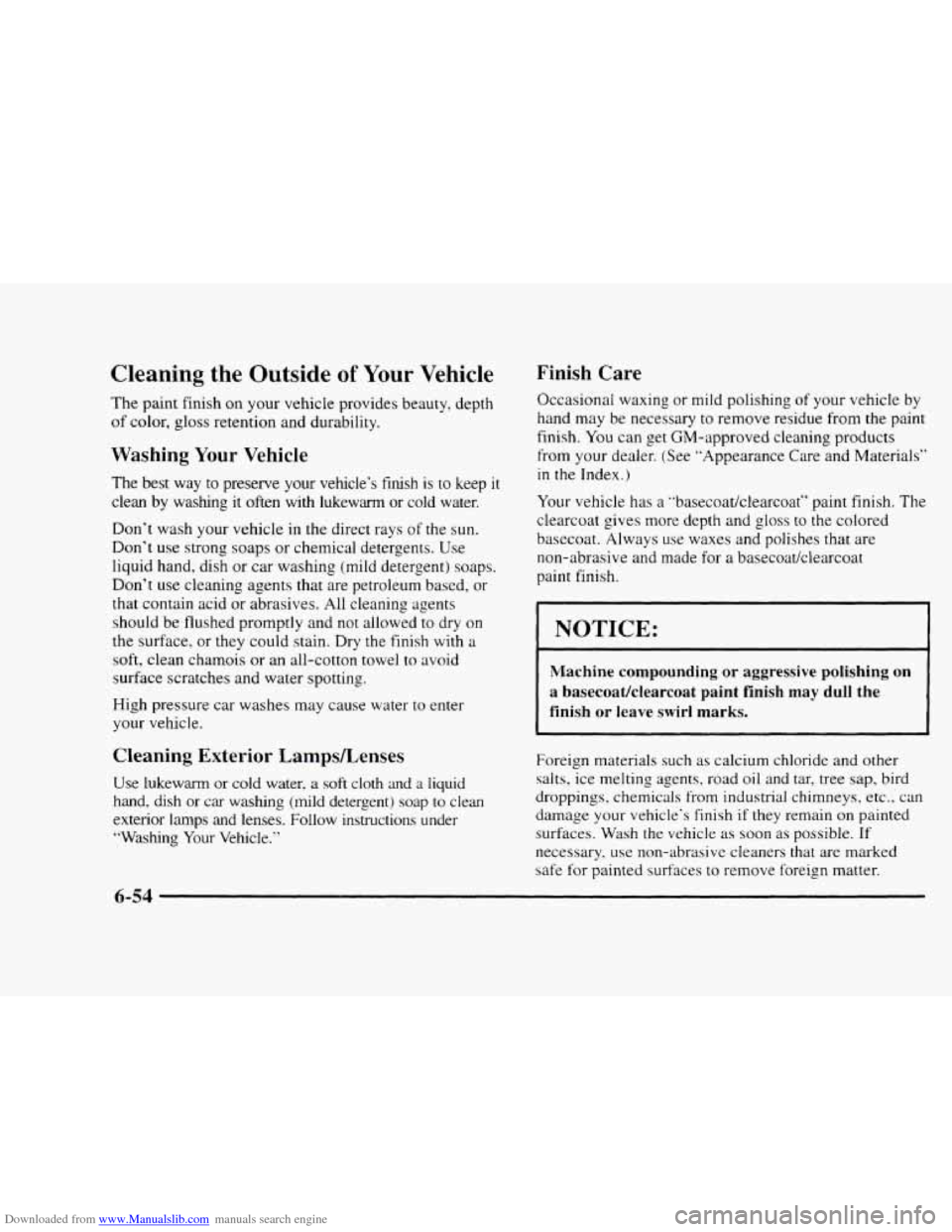
Downloaded from www.Manualslib.com manuals search engine Cleaning the Outside of Your Vehicle
The paint finish on your vehicle provides beauty, depth
of color,
gloss retention and durability.
Washing Your Vehicle
The best way to preserve your vehicle’s finish is to keep it
clean by washing it often with lukewarm or cold water.
Don’t wash your vehicle
in the direct rays of the sun.
Don’t use strong soaps or chemical detergents. Use
liquid hand, dish or car washing (mild detergent)
soaps.
Don’t use cleaning agents that are petroleum based, or
that contain acid or abrasives. All cleaning agents
should be flushed promptly and not allowed to dry on
the surface, or they could stain. Dry the finish with
a
soft, clean chamois or an all-cotton towel to avoid
surface scratches and water spotting.
High pressure car washes may cause water to enter
your vehicle.
Finish Care
Occasional waxing or mild polishing of your vehicle by
hand may be necessary to remove residue from the paint
finish.
You can get GM-approved cleaning products
from your dealer.
(See “Appearance Care and Materials”
in the Index.)
Your vehicle has a “basecoat/clearcoat” paint finish. The
clearcoat gives more depth and gloss to the colored
basecoat. Always use waxes and polishes that are
non-abrasive and made for a basecoat/clearcoat
paint finish.
I NOTICE:
Machine compounding or aggressive polishing on
a basecoatklearcoat paint finish
may dull the
finish or leave swirl marks.
Cleaning Exterior LampsLenses
Use lukewarm or cold water, a soft cloth and a liquid
hand, dish or car washing
(mild detergent) soap to clean
exterior lamps and lenses. Follow instructions under
“Washing Your Vehicle.“ Foreign materials
such as calcium chloride and other
salts. ice melting agents, road oil and tar, tree sap, bird
droppings. chemicals from industrial chimneys, etc.. can
damage your vehicle’s finish
if they remain on painted
surfaces. Wash the vehicle as soon as possible.
If
necessary, use non-abrasive cleaners that are marked
safe for painted surfaces
to remove foreign matter.
6-54
Page 318 of 402
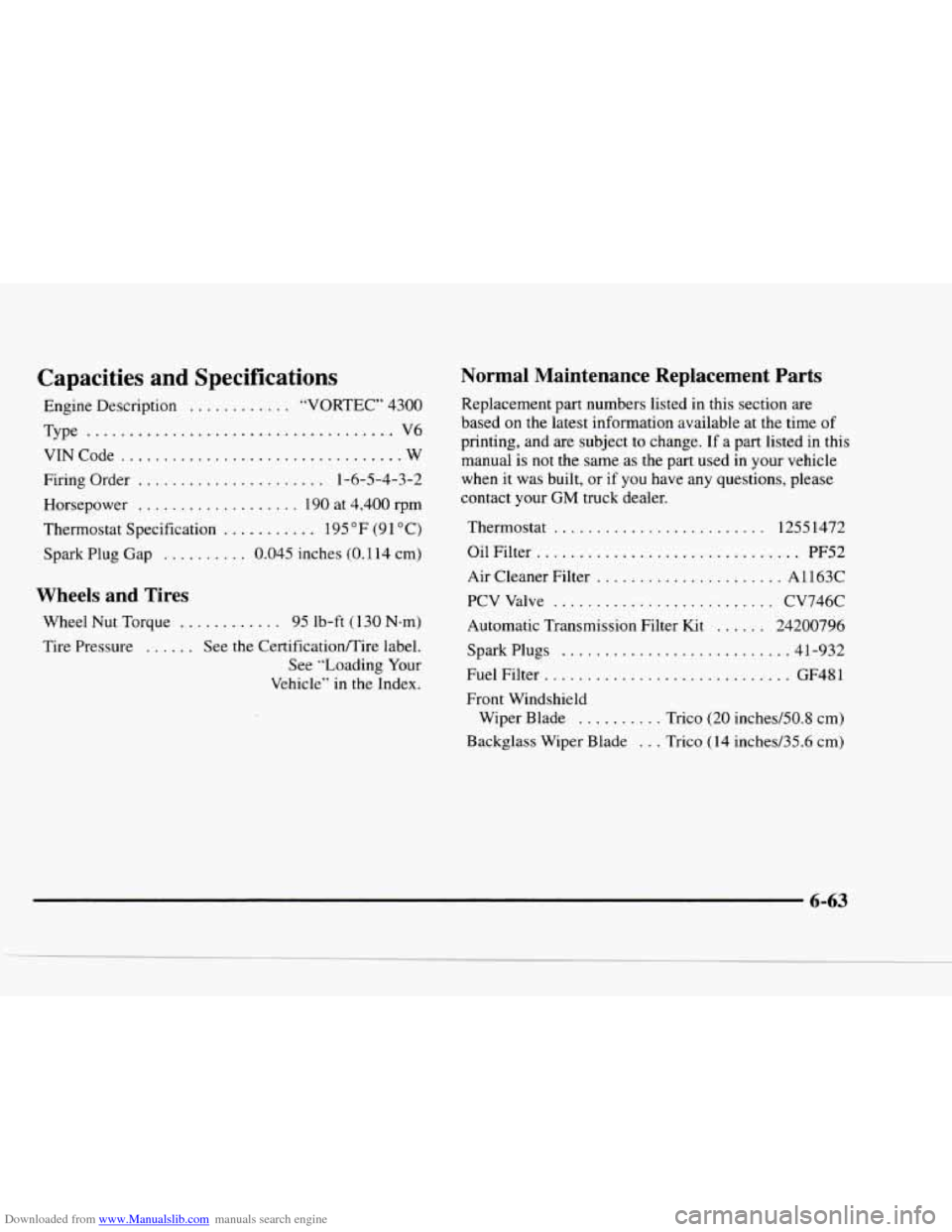
Downloaded from www.Manualslib.com manuals search engine Capacities and Specifications
Engine Description ............ “VORTEC” 4300
Type .................................... V6
VINCode
................................. W
Firing Order ...................... 1-6-5-4-3-2
Horsepower ................... 190 at 4,400 rpm
Thermostat Specification
........... 195°F (91°C)
Spark Plug Gap
.......... 0.045 inches (0.114 cm)
Wheels and Tires
Wheel Nut Torque ............ 95 Ib-ft (130 N-m)
Tire Pressure
...... See the Certificationflire label. See “Loading Your
Vehicle” in
the Index.
Normal Maintenance Replacement Parts
Replacement part numbers listed in this section are
based on the latest information available at the time
of
printing, and are subject to change. If a part listed in this
manual is not
the same as the part used in your vehicle
when it was built, or if
you have any questions, please
contact your
GM truck dealer.
Thermostat
......................... 12551472
Oil Filter
............................... PF52
Air Cleaner Filter
...................... A1 163C
PCV Valve
.......................... CV746C
Automatic Transmission Filter Kit
...... 24200796
Spark Plugs .......................... .4 1-932
Fuel Filter
............................. GF48 1
Front Windshield Wiper Blade
.......... Trico (20 inches/50.8 cm)
Backglass Wiper Blade
... Trico (14 inched35.6 cm)
6-63